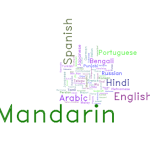A long time ago, I made a little script that converts whatever you type into animals. You can try it here. And you can download and play with the code here. And you can learn more about how it was done below… More »
My friend recently asked me how I make word clouds for presentations. Wordle is definitely a good choice. WordPress automatically makes word clouds out of my tags in the sidebar. But sometimes you can’t or don’t want to upload your data to places like WordPress or Wordle and you just want to use R (because you use R for everything else, so why not? Or is that just me?).
In a typical word cloud, word frequency is what determines the size of the word. As of this writing, the word cloud in my side bar (over there →) has “linguistics” and “programming” as clearly the largest words. Tags like “video games,” “language,” and “education” are also pretty big. There are also really small words like “Navajo” and “handwriting.” This reflects the frequency of each tag. Bigger tags are more frequent, so I write about linguistics a lot but not so much about Navajo in particular.
 Let’s just get this out of the way: There are, in fact, differences in the way men and women think, speak, act, etc. How much of that difference is due to nature and how much is due to nurture is up for debate. But that is not what this post is about.
Let’s just get this out of the way: There are, in fact, differences in the way men and women think, speak, act, etc. How much of that difference is due to nature and how much is due to nurture is up for debate. But that is not what this post is about.
This post is about a particular language myth that, for whatever reason, will not die. There are literally dozens of peer-reviewed, scientific studies refuting this myth, and yet the popular culture clings to it.
The myth I’m referring to is the idea that women talk more than men. More »
Every now and then I come across and article or a documentary which claims to reveal insights into an “ancient” language or culture. This video takes modern camera equipment to the the Khoisan people of Namibia, who are said to be an ancient tribe, with ancient ways of speaking and an ancient culture. This video takes out-of-context quotes to argue that Basque is an ancient and superior language and culture. More »
As I prepared to teach Intro to Linguistics this summer, my friend was poring over the Dothraki-English Dictionary, trying to find some morphologically interesting words for me to use in a homework assignment, when he discovered something interesting:
pika: [tʃoo] DP na. choo
Earlier this week, Chester Nez passed away. At 93, he was the last surviving Navajo Code Talker from WWII.
In the first half of the 20th century, linguistics as a science was still in it’s infancy. Outside of the communities where they were spoken, most people didn’t know about Native American languages . So in WWII, the US had a distinct advantage. Instead of making up codes to transmit secret messages over radio waves, only to have their codes cracked by clever enemies, they hired speakers of Native American languages to translate messages. Cracking the “code” of Navajo proved impossible, since it’s a language wholly unlike the European or East Asian languages most people are familiar with.
For centuries, people have bemoaned the downfall of the next generation’s language. The latest rendition of this fear comes in the form of a fear of the digital age. The New York Times just published a piece decrying the lack of handwriting – especially cursive handwriting – in the new Common Core standards. To support their claims, the article cites a study which links handwriting to greater activation in the brain.

